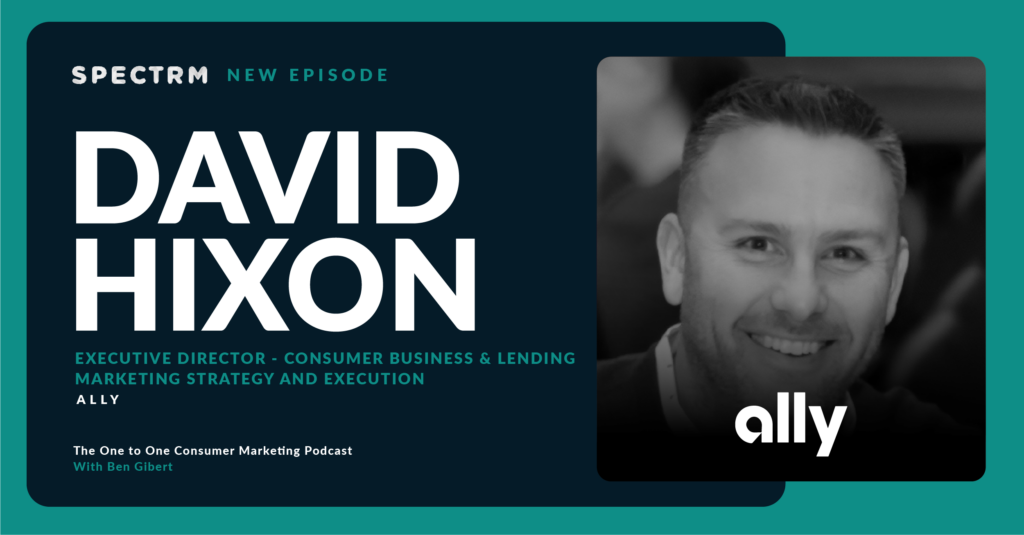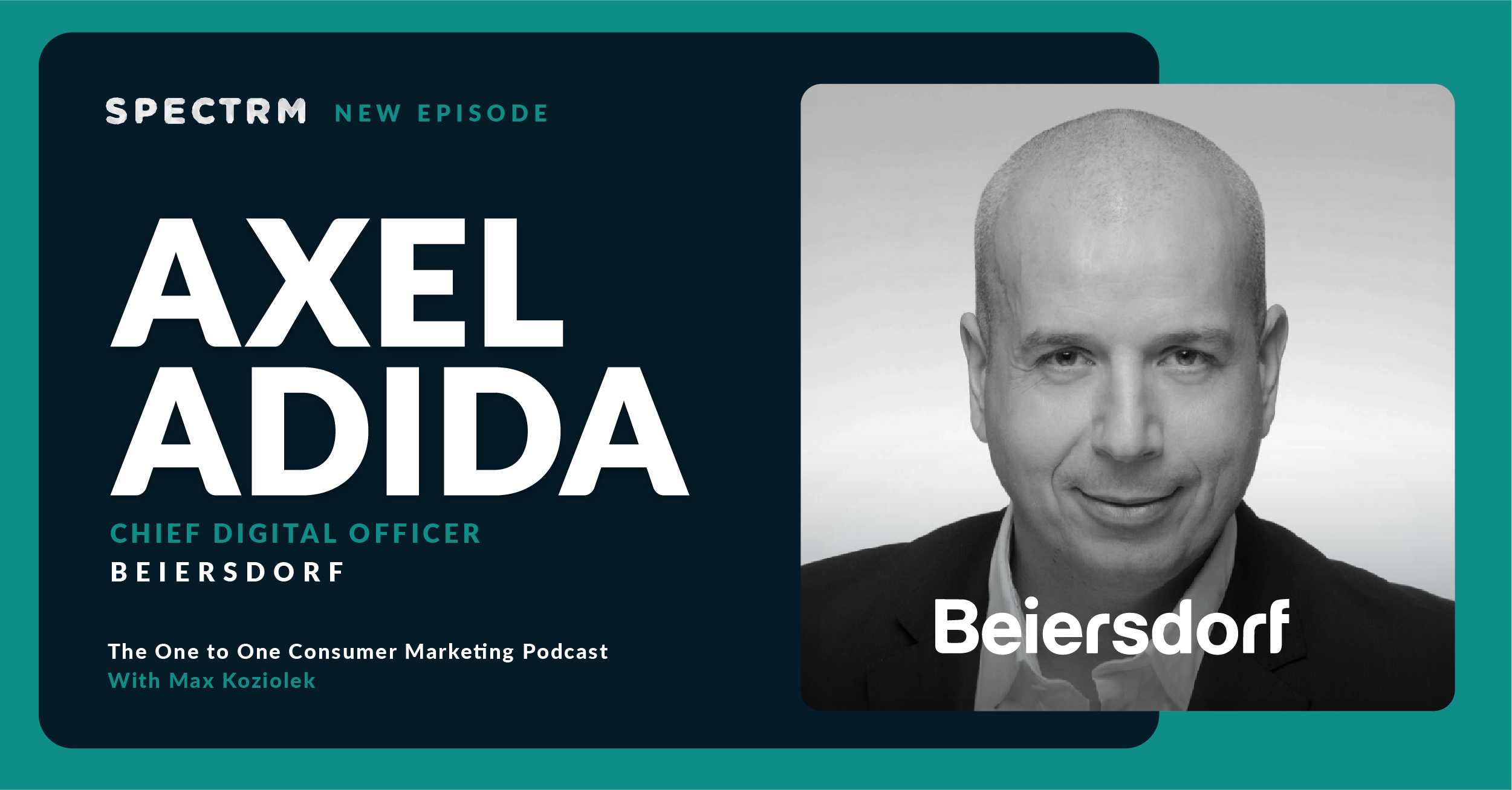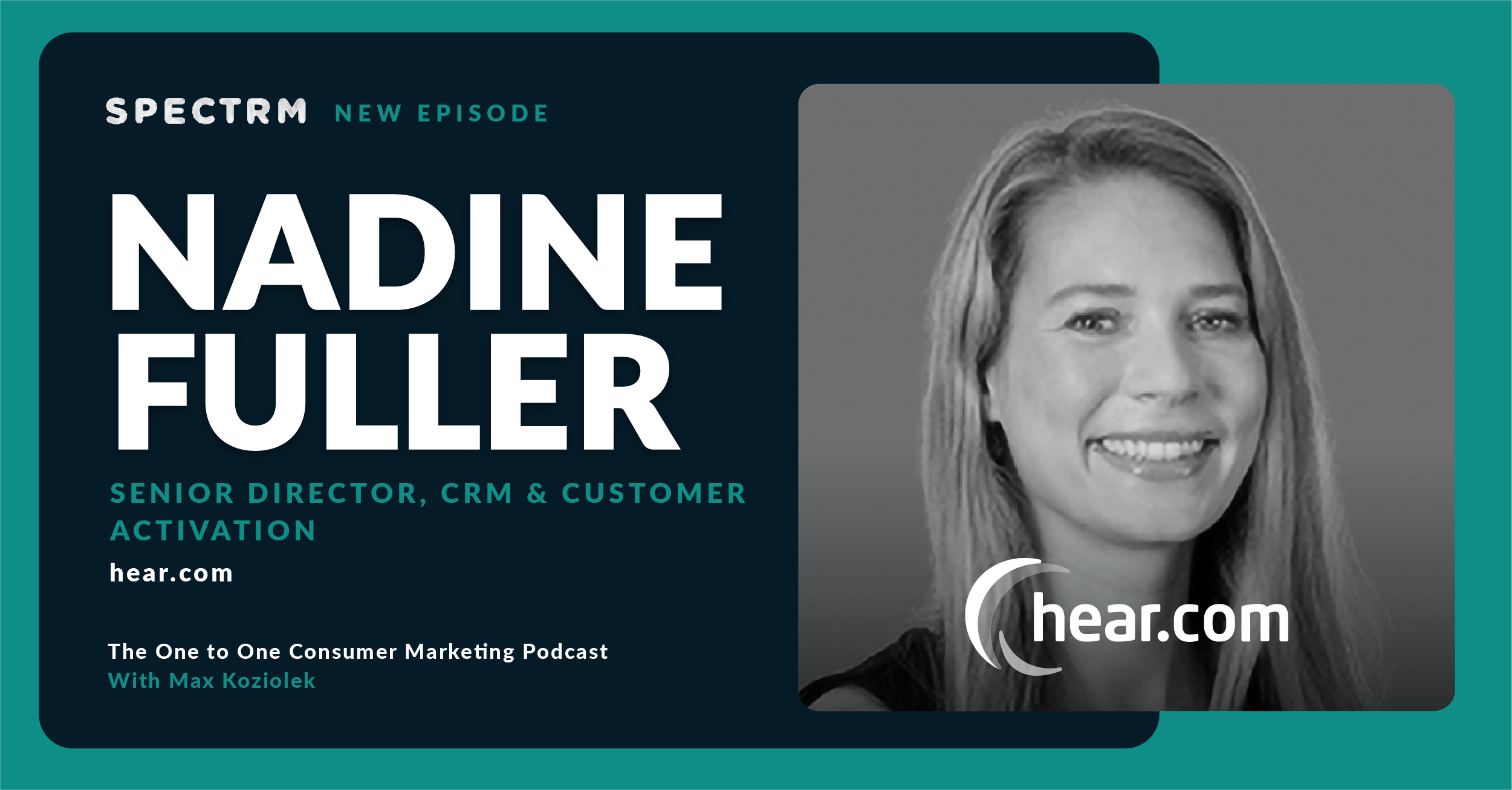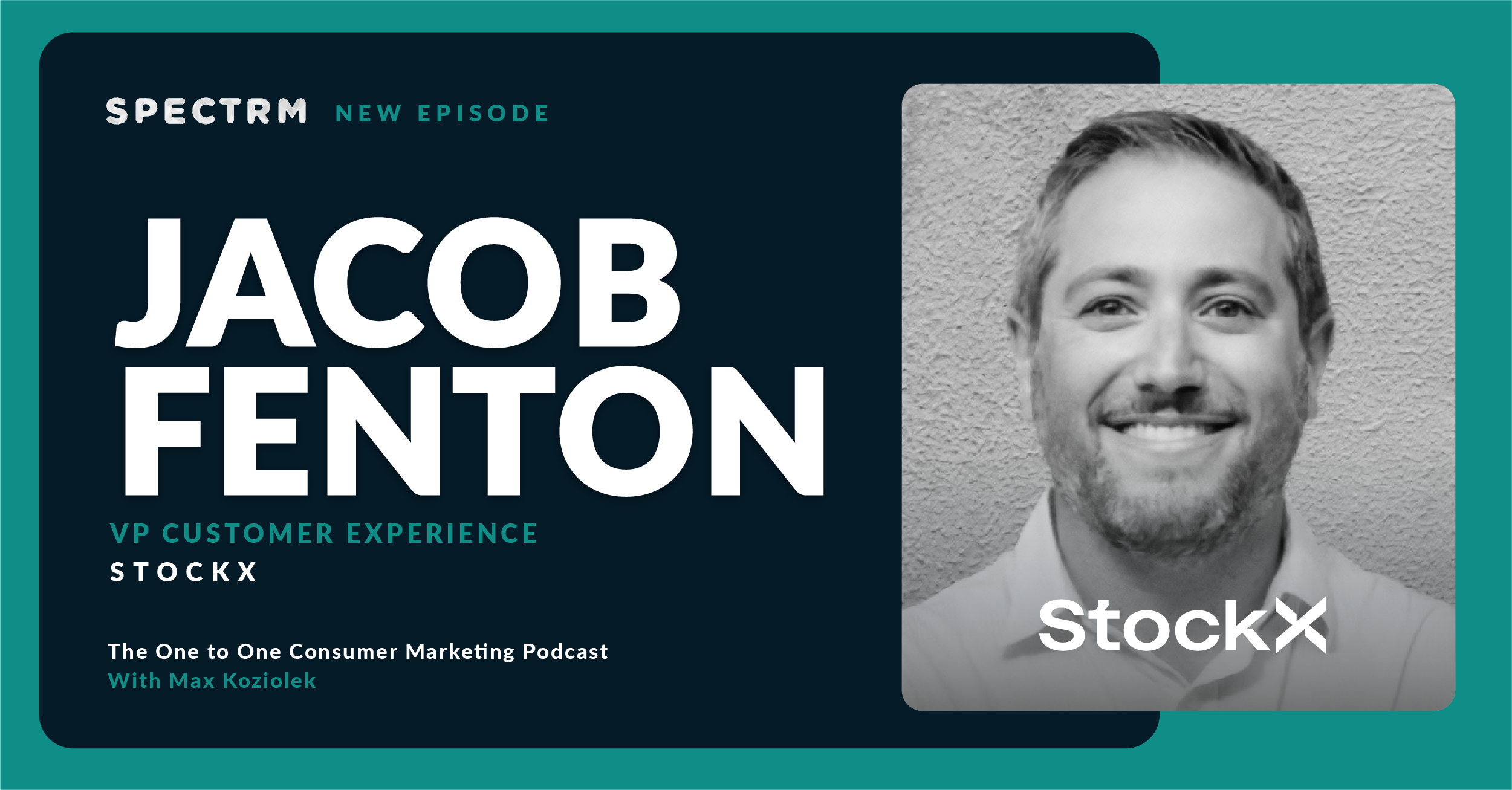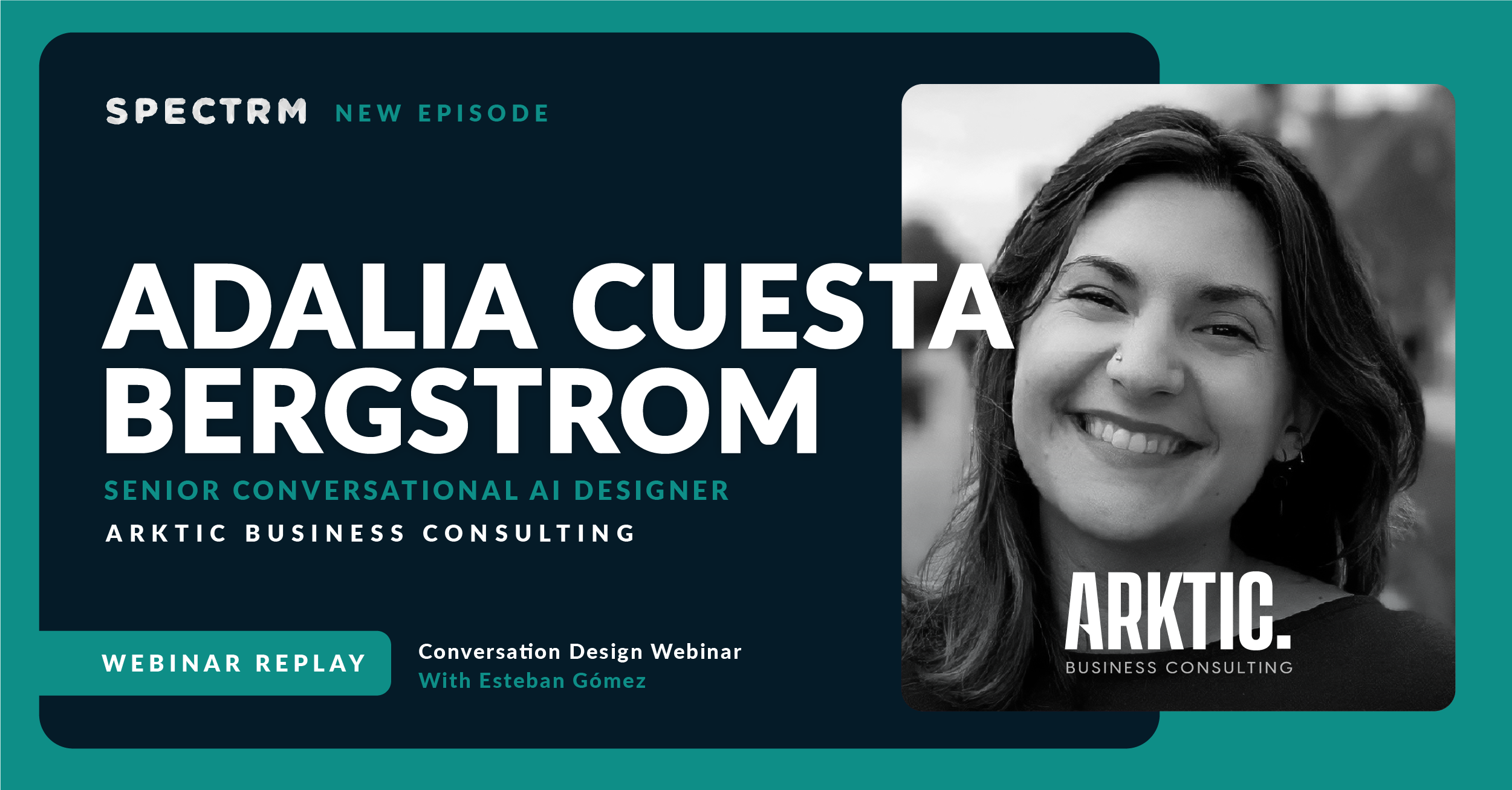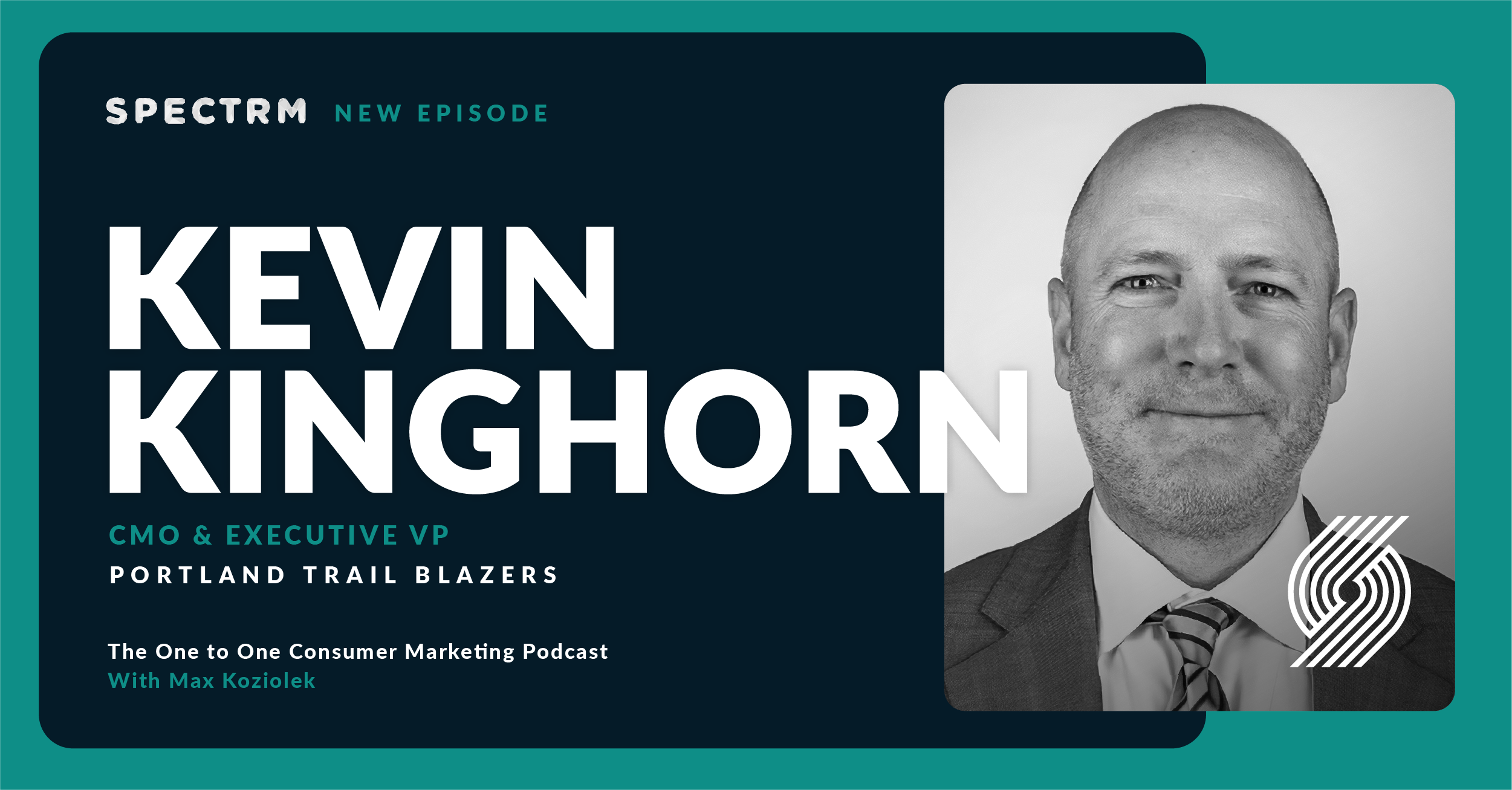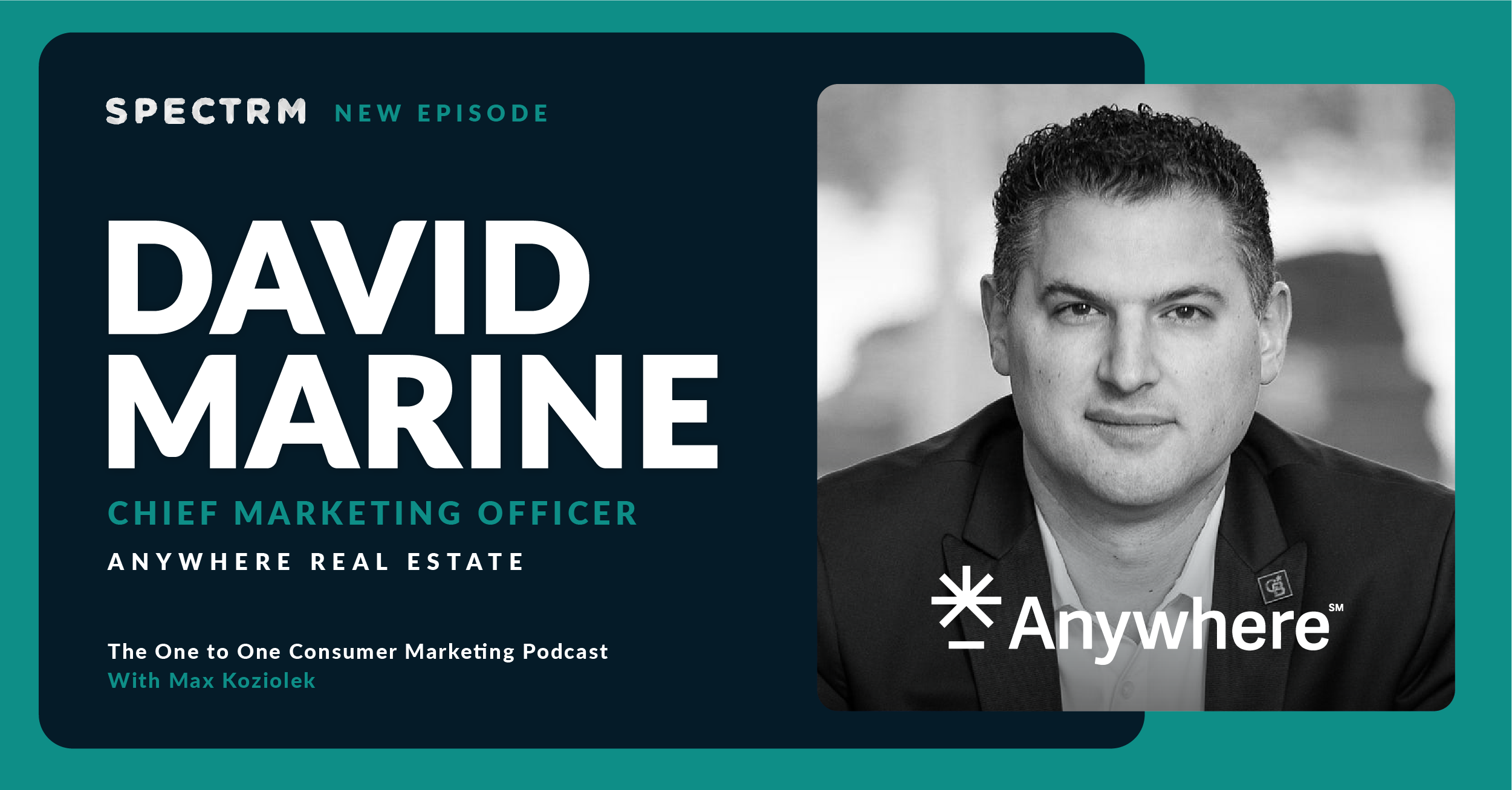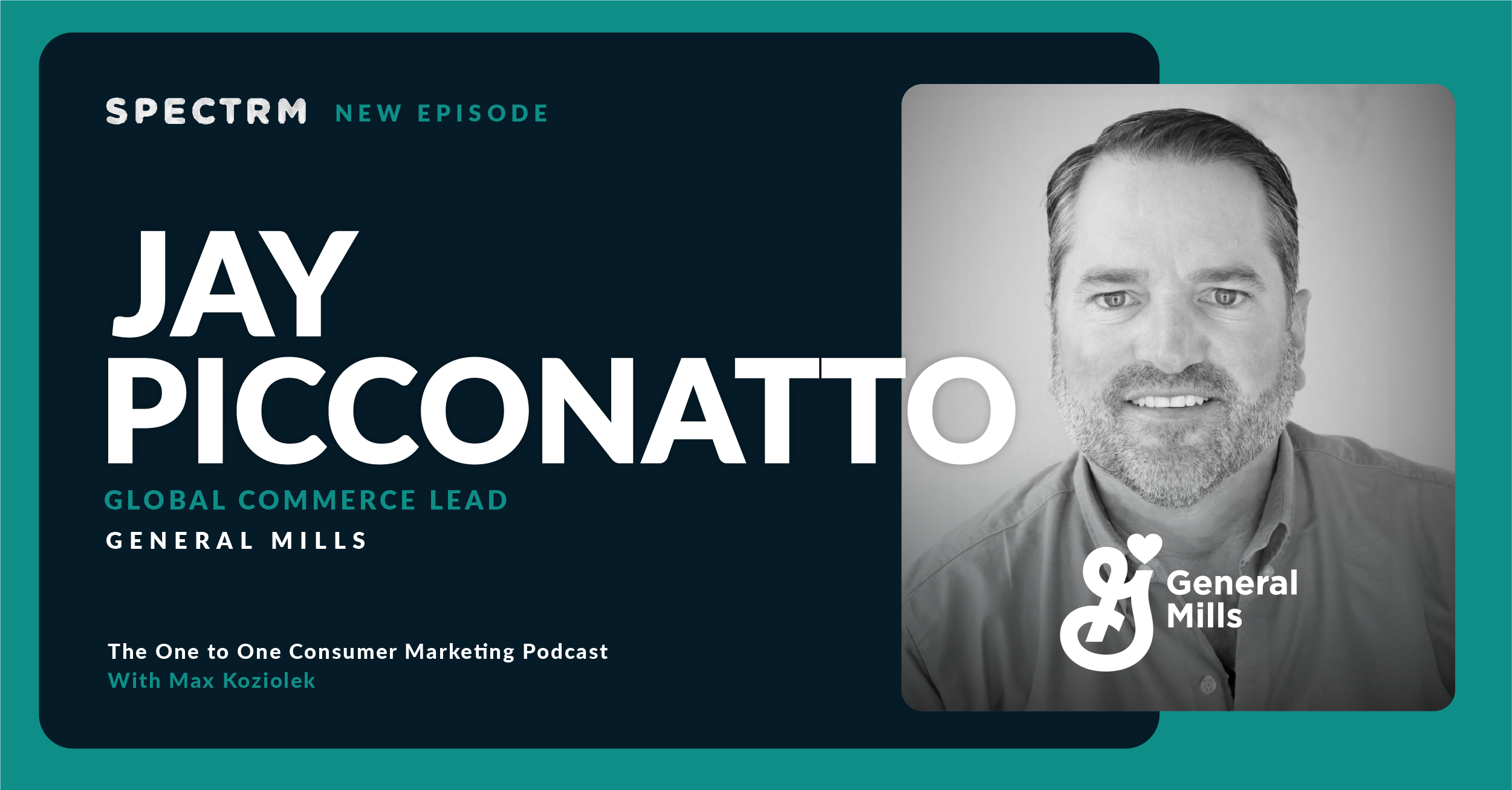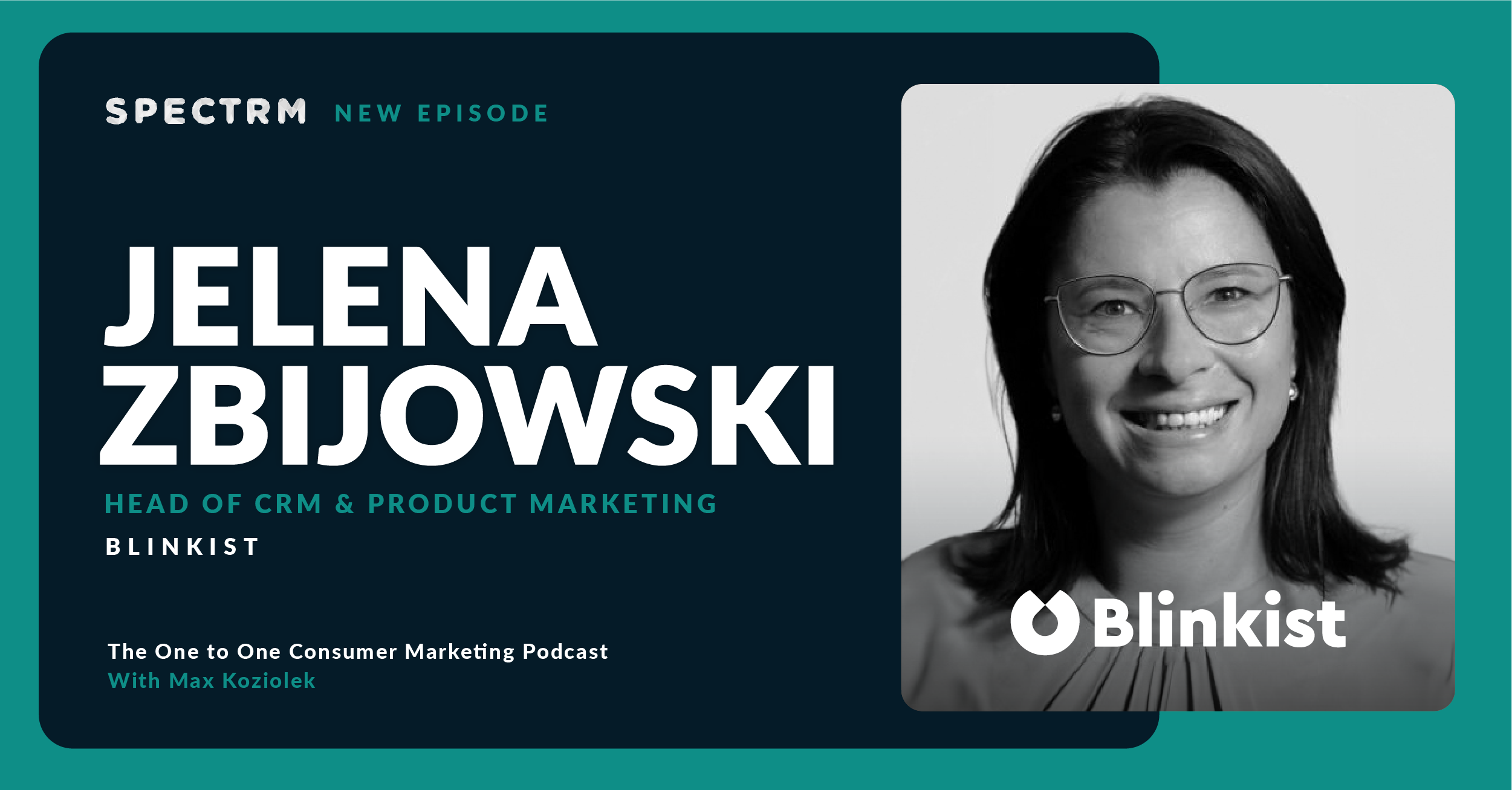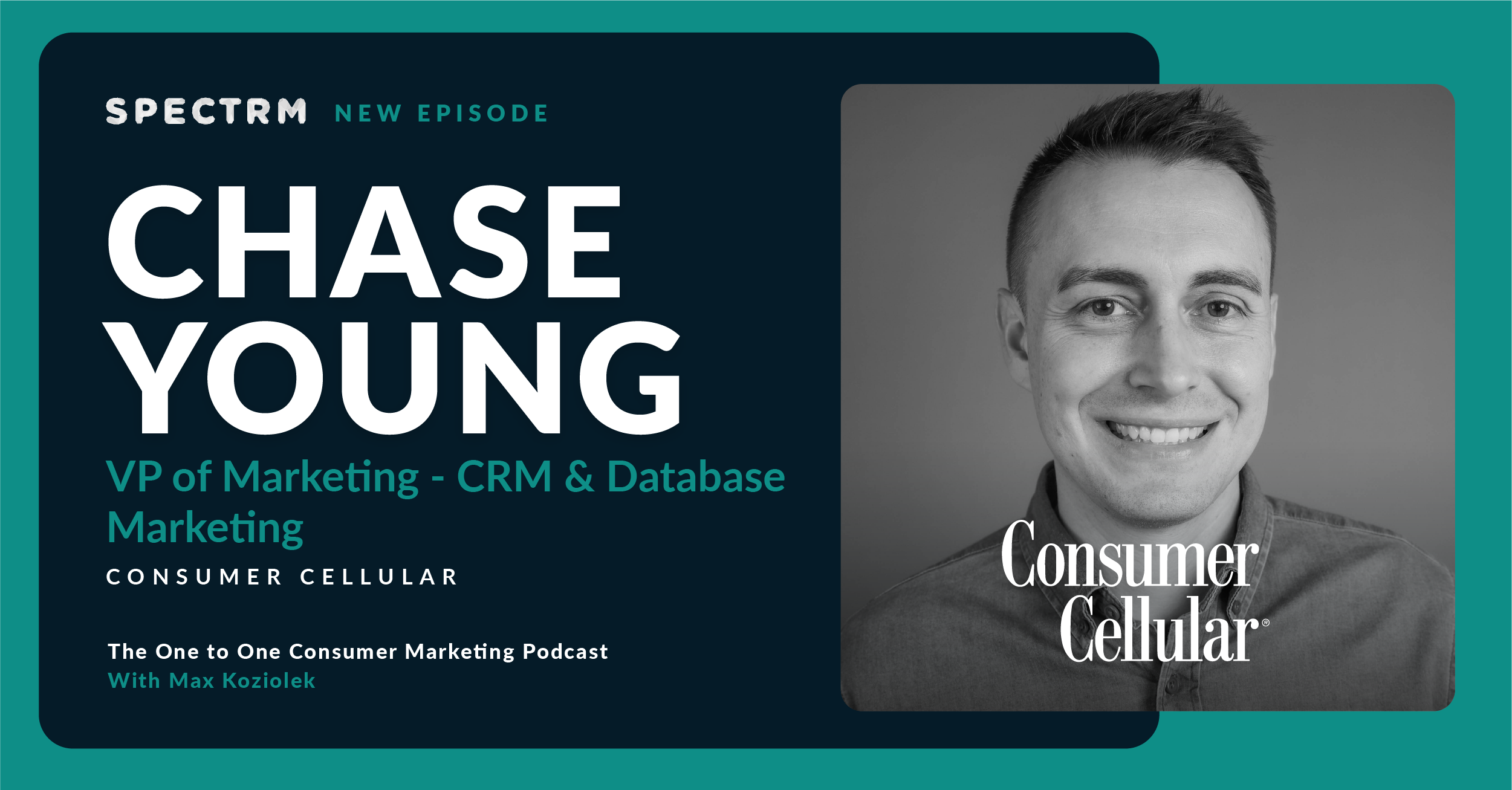Summary
Ben speaks with David Hixon, Executive Director, Consumer Business and Lending Marketing Strategy and Execution at Ally, a leading digital financial services company. They discuss the ways in which Ally engages with their customers, from the first introductory communication, to why they build relationships before selling on products, to the hyper-personalized experiences they provide on their website and app. They also talk about the challenges to consumer marketing today, especially in the financial services space, how Ally collects and utilizes zero-party data, the importance of retaining your loyal customers, and why success is building relationships with the people around you.
Topics discussed
- How Ally centers their marketing efforts on building relationships and trust through conversational communication, and why it’s important to them to wait two months before trying to sell on a new product.
- The challenges to consumer marketing, especially in the financial services industry, when customer behavior and sentiments are changing daily.
- How the marketing team is structured, and how it sits traditional marketers alongside analysts and statisticians to have the “trifecta of what you would want for a good marketing strategy.”
- Why Ally has retention rates in the high 90%, and why customers of multiple business lines have lower attrition, higher balance growth, and more engagement.
- The challenges to consumer marketing, including finding the right product for the right people, and the “conversational choreography” needed to make sure the right customer is getting the right message at the right time.
- A behind-the-scenes look at how Ally leverages the data they have about customers to drive its hundreds of trigger campaigns and to create 6,000 unique variations of Ally.com to highly personalize their customers’ experiences.
- The excitement around using zero-party data to drive better customer experiences through hyper-personalization, and how Ally gathers that data through, for example, their online savings account buckets.
- Advice for young marketers, including understanding how important data is to marketing efforts, and how success is about building relationships with the people you work with.
So from a marketing perspective, we know that engagement leads to cross sell. So we really spend as much time trying to drive that engagement as we do trying to deepen relationships, because we know one is causal of the other. So while the Holy Grail of this whole thing is to get that next product open, there's a lot of work that goes into building that relationship with somebody so that when it is time to sell the product, it doesn't just feel like a cold call or a knock on your door or something like that on a Sunday morning. It truly is much more of relationship building and less of just cross sell.
Guest biography

David Hixon
Executive Director, Consumer Business & Lending Marketing Strategy and Execution
Ally
- Marketing / Marketing Analytics / Marketing Strategy / NBA Statistician
Company overview
Ally Financial Inc. (NYSE: ALLY) is a leading digital financial services company and a top 25 U.S. financial holding company offering financial products for consumers, businesses, automotive dealers and corporate clients.
Industry: financial services | www.ally.com
Subscribe to the podcast newsletter
Transcript
00:00
Intro
From a marketing perspective, we know that engagement leads to crosssell. We really spend as much time trying to drive that engagement as we do trying to deepen relationships because we know one is causal of the other. While the Holy grail of this whole thing is to get that next product opened, there’s a lot of work that goes into building that relationship with somebody so that when it is time to sell the product, it doesn’t just feel like a cold call or a knock on your door or something like that on a Sunday morning. It truly is much more of relationship building and less of just crosssell.
00:39
Ben Gibert
Hey everyone, and thanks for listening to and watching the one to one consumer marketing podcast. Today I’m speaking with David Hickson, who is executive director of marketing at Ally Financial, a top 25 US. Financial holding company and a leading digital financial services provider. David, thanks so much for chatting with me today.
00:57
David Hixon
Yeah, thanks for having me. I’m excited to be here.
00:59
Ben Gibert
Yeah, I’m really looking forward into digging into our conversation. Before we get started, can you tell our audience about yourself, your background, and how you ended up at your current role at Ally?
01:10
David Hixon
Yeah, sure. So I’m down in Charlotte, North Carolina. I’ve been at Ally for about seven years. My background is heavy analytics. Prior to being at Ally, I worked for a publicist agency called Hawkeye for about 15 years, almost 15 years, leading their analytics practice. Towards the end of my tenure on the agency side, we had won Ally as a client and started doing some work with them. As often happens in the agency relationships, I kind of got tapped on the shoulder to come over. Seemed like an interesting opportunity. Came over to Ally, this would have been 2015 ish late 2015. I was really brought over not even into the marketing organization. I was brought over onto the business side to start to build out some level of marketing analytics capabilities. It probably sounds weird that was being done outside of marketing, but back then, Ally was much smaller than it is today and really just trying to build anywhere they could build.
02:08
David Hixon
I came over on the business side, started getting into some level of marketing measurement, and then have since really just expanded. I’ve now moved over into the marketing world and lead all of the line of business level marketing. Think of like traditional conversion tactics for any ones of our lines of business. Deposits, auto insurance, mortgage brokerage, that comes out of my team. The delineation there is what I don’t do is traditional above the line advertising, sponsorships, and brand type stuff like that. Anything conversion focused is in my wheelhouse and it really is all born from analytics. I was in analytics before I was in marketing, so I’m definitely a data guy.
02:48
Ben Gibert
Nice. Yeah, I think it speaks volumes of allies approach that you’ve gone through that analytics first, building that out and then you’ve kind of gotten more and more involved. On the marketing side, I’m assuming you also have built out a whole testing process, all kinds of things related to analytics. Can you speak more to your background in analytics and then what you brought into Ally and how you’ve seen the industry change?
03:12
David Hixon
I guess my analytics background was, at least in my mind, traditional marketing analytics. Meaning I’ve been fingers to keyboard building like propensity models and response models and segmentation and targeting strategies and designs of experiment, which for me is all about measurement and optimization. I came over to Ally, that mindset didn’t exist. Frankly, that mindset didn’t really need to exist because there wasn’t enough marketing going on to warrant any meaningful optimization. Since I’ve come over, a big part of our business strategy revolves around relationship deepening, aka crosssell. We don’t love to say crosssell, that’s kind of a bad word, but relationship deepening for us, which is at Ally, we have 4 million auto customers, we have 3 million deposit customers, and then we have all these other ancillary lines of business that are trying to suck customers out of those other lines of business. Think mortgage, think brokerage, think insurance, think credit card now.
04:11
David Hixon
The analytics that I do is really all about finding the right people in those 7 million existing customers that are interested in a credit card at the right time, in the right channel for the right reasons and things like that. Our team is built or set up, which I think is really interesting and unique, where we’re not just a team of analysts, part of our team is analysts, but those same data driven statisticians sit across the table from more traditional marketers. You’ve got the left brain, right brain thing working together, which drives measurable marketing outreaches that we learn from and optimize every single day.
04:48
Ben Gibert
Yeah, that’s so interesting. You mentioned obviously the different cross sell being a dirty word. I’d love to dig into that. Why that’s a dirty word for you? But I think understanding too. You mentioned team structure. Obviously it sounds like you’re probably very deeply involved in the CRM side of things, right? Like identifying customer cohorts, how to cross sell. Can you talk to like how the team is structured in order to deliver kind of that deepening of relationships? I think that’s also a very interesting way to frame that. What does deepening relationships mean beyond obviously selling more of the business across the different units?
05:22
David Hixon
Yeah, that’s a good one because there’s a lot to it. There’s probably four or five questions in that one question. This part of the marketing team at Ally is probably 75 people. You’ve got what I think of as like traditional marketers that are coming up with marketing strategies and working with our ad agencies to develop creatives that tie to that strategy. On top of that, you’ve got what we think of as two levels of analytic partners. One of them is going to be the type of partner that’s going to say, and I’ll obviously grossly oversimplify this, but the type of partner that’s going to say, okay, you want to sell a mortgage to an auto customer? Well, I have 4 million of those and 90% of them are marketable in this channel. So, like, they’re building the marketable segments. We have another team of analysts that are statisticians that are more about, okay, well, of those, whatever, 3 million people that are eligible for the product here’s, the 300 that based off of our propensity model are most likely to be interested in that product.
06:24
David Hixon
You tie those three groups together and you really have like the trifecta of what you would want for a good marketing strategy. That’s how the team is built in terms of how we think about that relationship deepening. You’re right. It is more than just making that offer, like, hey, you don’t have a mortgage with us, would you like one? It’s much more than that. Some of the stuff that we’ve learned is a customer is far more likely. Really this stuff is incredibly intuitive, but when you see it come to life in data, it kind of takes a different shape. The customers within our portfolio that are more likely to be interested in other products are always the most engaged customers. At a bank, engagement means a lot of things. It means you’re logging in and checking your balances a lot, you’re moving money in a lot.
07:10
David Hixon
You’re engaged in all of our budgeting tools a lot. We do from a marketing perspective, we know that engagement leads to crosssell. We really spend as much time trying to drive that engagement as we do trying to deepen relationships because we know one is causal of the other. While the Holy grail of this whole thing is to get that next product opened, there’s a lot of work that goes into building that relationship with somebody so that when it is time to sell the product, it doesn’t just feel like a cold call or a knock on your door or something like that on a Sunday morning. It truly is much more of relationship building and less of just crosssell.
07:47
Ben Gibert
Yeah, I think even just the fact that you’ve termed it that obviously highlights your philosophical approach to everything, which then has a big impact on the strategy and tactics. Thank you also for the overview of the teams. I always find it tells a lot about a company, the way that they structure their teams and how they’re thinking about tackling a particular problem, maybe taking a bit of a step back from Ally and looking more broadly at the market, kind of how would you summarize the current state of consumer marketing?
08:15
David Hixon
The word that jumps in my mind is just complicated. Take a step back from ally, it’s kind of hard to do because that’s my life. Just in the financial services industry in general, as you can imagine, what’s gone on over the last several weeks, and even really prior to that, the economy is in a very weird place right now. To be a bank trying to get people to become customers and allow us to help them with their financial lives is just complicated. The work that we do is really all about, I guess, really the work that all marketers do is really all about just changing behavior, right? Like getting you to do something that you weren’t otherwise going to do. In our world, that behavior that we’re trying to change is constantly shifting. Here at Ally, we shift between, okay, guys, today we want to focus on getting new customers in the door.
09:04
David Hixon
That’s what’s most important. Let’s figure out how to go build a really smart acquisition strategy. Well, then tomorrow it might be, hey, let’s go get the existing customers that we have to build their balances with us faster. Let’s go figure out a really smart balance build strategy. Or it might be like we talked about relationship deepening or driving engagement. It’s a complicated world that we’re living in, trying to figure out what’s the right behavior to change that gets us to the long term goal that we’re after as a business. That’s the thing that has us kind of running around with chickens with our head cut off a lot around here.
09:34
Ben Gibert
Yeah, I believe it. It’s a tough time to be a marketer in general right now. I think it’s probably an even tougher time to be a marketer in the financial services industry. You mentioned deepening relationships. Obviously, trust is a huge part of deepening relationships. Has it become more challenging to build trust right now, given the kind of economic climate or given what we’re seeing in the financial markets and kind of the fear of what’s going on with banks?
09:59
David Hixon
Well, it’s not that it’s more difficult. I think it’s becoming more important, right. Like, trust is important with the bank, and we’ve always done a really good job of that in terms of our customers feeling like they’re in the right space. I wouldn’t say it’s become more difficult. It has become more of an area of focus. For us, I think the way that we do that is we treat and actually, coincidentally, it’s this graph behind me here or this chart behind me. We treat our conversations with our customers, much like I would treat a conversation with you if I met you on the street during lunch. When a new customer comes in our door, we’re introducing you to who we are as a company. We’re introducing you to who we are as a brand. We’re talking to you about all the features of the product that you already purchased with us.
10:47
David Hixon
We’re talking to you about what we do in the community. We’re talking to you about financial literacy and education. We spend a good call it at least two months having conversations like that with our customers before we ever try to sell you anything else. That’s very purposeful and we’ve seen that work too. It’s building that foundational relationship which is in a lot of ways trust based, that then leads to actually changing that behavior and driving more conversion.
11:14
Ben Gibert
Yeah, I love that because I think as marketers we talk a lot about having conversations with customers, but then we also tend to focus on talking at customers rather than listening to customers and actually engaging them in conversations. I think it’s not easy to do that at scale. I think if you can crack that nut, there is so much value to unlock there. I mean, you mentioned also shifts depending on today we might be focusing on acquisition, getting more customers through the door. Tomorrow might be about retention and growing customer LTV, for example. How do you think about customer retention and lifecycle marketing? How does that fit into your company strategy and your marketing team strategy?
11:54
David Hixon
Yeah, so retention, believe it or not, is not really a problem for us. I think our retention rate is in the high 90s, believe it or not, so we do really well there. I believe that’s primarily because of two things. One, we have a brand that people have an affinity for and really kind of flock towards and two, our products are priced really attractively, so there’s not a lot of reason to leave. Loyalty, though, is very important. When I think of loyalty, I kind of go back to what we’ve already been talking about, which is relationship deepening and the reason that’s so important. I can rattle off a few stats out of memory here, but we’re trying to scale and grow new lines of business. We started out as an auto lender, then we became a deposits bank. We turned the corner and said, hey, let’s become a full service financial institution which includes mortgage and brokerage and insurance and credit card and all those other things that you need to live your financial life.
12:47
David Hixon
We’re trying to scale those businesses through relationship deepening because it’s so efficient to do it that way. I was given a presentation a few weeks ago around for us to go out and acquire a new brokerage customer. Think like traditional marketing channels, like programmatic or affiliate channels or rate tables, things like that. It costs us somewhere in the neighborhood of 16 times more to do that than to extract a brokerage customer from our existing customer base. It sounds like a really great story to talk about crosssell and loyalty and retention and relationship deepening without using numbers like that. At the end of the day, there are economics involved. The bottom line is it’s really efficient to build businesses this way. That’s why back to your original question. How do we think of loyalty? That is loyalty. Loyalty is an avenue by which we scale these lines of business.
13:42
Ben Gibert
Yeah, I mean, I think that makes perfect sense, too, given in the climate right now where it hits, you do more with less, but that is what marketers are being challenged to do a lot of the time. And you’re right. I mean, it’s interesting that you share those numbers because what we’re seeing across the board, too, is it’s not new that it’s harder and more expensive to acquire a customer than retain an existing customer. Those multiples are pretty crazy when you start looking at the unit economics of it and something like the scale that Ally Financial is operating at. I think you’re also in a unique position, too, where you have all of these different business units that you can actually offer people, and you have this huge database of people that you can leverage for that. I think that is a good way to think about loyalty.
14:25
Ben Gibert
Also, just ultimately from the metric of how much revenue do they drive for the business and can we get for that?
14:33
David Hixon
That’s right. It’s also we see that our customers of multiple lines of business of ours are just better customers anyhow, so were able to more efficiently acquire them and they grow and provide more revenue than a single line of business customer. We see lower attrition rates, we see higher balance growth rates. We see just more engagement in general. It’s like the circle of life, right? It’s a really efficient way to go get a new customer that’s going to be the best customer you could have gotten. It really is a foundational strategy for us at Ally.
15:07
Ben Gibert
Yeah. Then, I guess, like you said, ultimately also increases the value across each individual business unit of that customer as well. It’s like a never ending cycle of growing value, which is, I think, a great way to think about, I mean, lifecycle marketing in general. Retention, however you want to phrase it, is doing that. I mean, obviously there are huge upsides to this. There are also major challenges to execute on this. Can you talk through some of the major challenges that you’re seeing right now?
15:34
David Hixon
Yeah, the challenges are making sure we have the right product for the right population of customers. That’s a big one. So, for instance, our deposit space of customers, generally speaking, is a pretty affluent group of people, and that’s primarily because we pay really high rates on our savings and on our liquid savings accounts or our deposit accounts. It attracts a certain type of person that’s savvy to rates, and that’s the demographic of what we get on the deposit side. Contrast that with we recently purchased a credit card company that comes with a product suite that doesn’t yet align with that level of influence. It’s a lower credit tier product at this point, and trying to find the right people that fit that product is a challenge in those scenarios. That’s one I think the other one is really kind of just like the corporate idea of I have lots of bosses at Ally.
16:28
David Hixon
My bosses are the heads of these lines of business, and all of them want as much as they can get from crosssell because of the stuff I was rattling off earlier around efficiency. So, I mean, frankly, there’s a lot of conversation choreography that has to happen, right. Because I can’t be in the morning, I want to talk to you about mortgage, and then at lunchtime it’s going to be brokerage, and then afternoon it’s going to be about credit card. We have to find a way to make the conversation make sense to the consumer so that they don’t just feel inundated with us trying to cram every product we have down their throat. We spend a lot of time on customer experience, making sure that there’s kind of a hierarchy or a waterfall that goes into, okay, I haven’t spoken to you about this in this many days, but you triggered for this product, so it’s okay to talk to you about that tomorrow.
17:14
David Hixon
There’s a lot of that type of choreography that happens to make the conversation feel right.
17:18
Ben Gibert
I love that term. That might be the first time I’ve heard the term conversation choreography. I’ve heard other people talk about orchestration whatever you want, but that is a really great term, particularly in the context of how you think about it in terms of having conversations with your customers. Can you dig into that ? I know there’s the complexity. How do you manage all of that? How do what’s the right time? What are they engaging with? Can you walk through maybe whether it’s the tech stack, the measurement, like the different pieces that you put that puzzle together?
17:48
David Hixon
Yes. Generally speaking, I guess the way we think of it is at the highest level I want to have, and it really is truly this chart behind me, which is like, we’re not going to try to sell you anything until we get into a good point in our relationship. Right. There’s a period of time where you are getting a very regimented set of communications, really, no matter what you do. Like, you might trigger for a particular product, but it feels too early for us to talk to you about that. So we’re going to get through this. It’s basically we call it Emob early month on book. Once you get through that, then we’re going to keep a steady of awareness for the other products that we have. That might be a monthly email that talks to you about what it means to be a homeowner, right?
18:29
David Hixon
Like, it’s not a hard hitting conversion message. It’s just a subtle reminder that we have mortgages as part of our product suite. What sits beneath that is a huge suite of behavioral triggers that we have on all of our customers. That’s the beauty of a being a bank with lots of data and b being focused on upselling existing customers. We have just a boatload of data that we use to drive all this stuff. We have literally hundreds of trigger campaigns that go out every single day that are based off of things like specific transactions you make in your account that lead us to believe something’s going on. It could be your behavior. On Ally, which is our storefront, we don’t have branches, so we watch people’s activity on our site and react accordingly. We work with, I don’t know, five or six different third party data vendors that feed us data about our customers that tell us when things happen that might be predictive of them being in the market for a specific product.
19:26
David Hixon
Lots and lots of data feeds in at the customer level, and then we just take it all and build, like, a prioritization hierarchy that says, what? Today was the day that you were going to get your mortgage awareness message. I saw you on a credit trigger the day before yesterday, which triggered a communications journey in and of itself. I’m going to remove you from the awareness message that you were going to get. That’s one very simple example that would be like a huge decision tree that would take up the whole whiteboard over here. What I think is most interesting about it is I think it could sound really sexy to talk about it in terms of algorithms and AI and all the terms that are out there right now. We do some of that and we use that technology where it’s appropriate, but I think it’s more like we sit down and think of this in the eyes of a consumer and say, what?
20:17
David Hixon
You were in my inbox the day before yesterday. I don’t want to hear from you again until next week. We come to consensus that’s what feels right and that’s what we build into the system.
20:26
Ben Gibert
Yeah, I think that’s so key, and I love that they always just taking a step back from the entire how much data you have and all the ways you could engage and thinking about it more from the customer perspective, like, what do I actually want as a customer? I do think that as excited as people are about AI, I have yet to see predictive AI for CRM and the types of orchestration that you’re talking about yet, it could come. I think getting down to the nitty gritty of actually building that insanely complex decision tree, it does take people, and it takes people because ultimately you’re thinking about the people on the other side, like how do we want to engage in human, how do we get back to those first principles? I think that’s I’d love to hear you talk through that. That’s obviously on the tech side, the data side, like all of the ways that you can engage customers when you are engaging, can you talk about the channels you use and if you’re seeing certain channels perform better than others?
21:19
David Hixon
Yeah. So we are a digital bank, obviously. So we are digital, digital. We do very little direct mail. I’ll just throw that out there. We don’t have the traditional acquisition channels that some of the other big banks that our competitors might do, where we’re dropping hundreds of millions of direct mail pieces to acquire credit card customers as an example. We’re heavy in programmatic, we’re heavy in those types of digital channels and rate tables here and there. Really where we get the biggest bang for our buck is our own channels. As we go back to what I was just talking about with Relationship Deepening, we’re focused on, we do a lot of emailing and like we just talked about, we try to keep it at an appropriate level. We obviously are monitoring unsubscribes and engagement levels and the emails and things like that to help optimize.
22:02
David Hixon
Really one of our other biggest channels is what we call our storefront, which is Ally, and there’s really three pieces to that. There is truly Ally, which is a very targeted channel for us. There’s also the authenticated part of Ally, which is where a customer would go in and check their balances. We have a few marketing placements in there and then we have the mobile app, which really only has, call it less than five or six marketing placements in there that we can use for obvious reasons. Like when you’re in your mobile app as a customer, you don’t want to be inundated with marketing messages, you want to check your balance or pay your bills or transfer your funds, whatever you want to do. We use so when I was describing my team to you earlier, part of the team that is the more statistician type role that’s building predictive models.
22:44
David Hixon
We have a next best offer model that drives those three digital channels, allied, Authenticated and Mobile. And that model updates every single day. It’s going to say today David’s next best offer is life insurance. It’s going to completely change the experience you have in all three of those channels. I think the last numbers I’ve seen is that the next best offer model today drives 6000 different unique variations of Ally. It gives us a channel to get really personalized based off of all the stuff that feeds into those models, which, again, is what? The data we talked about earlier. It could be transactions. It could be third party stuff. It could be interactions on the site. It allows us to get a pretty good feel for, hey, I have your eyeballs right now, right? Because you’re at ally.com for whatever reason. I might as well try to show you something that I think you’re most likely to be interested in.
23:34
David Hixon
That’s how that next best offer model works. Sorry. Long winded answer, but heavy digital channels, primarily email and then onsite in an app.
23:42
Ben Gibert
Yeah, I love that because there is so much complexity involved. I’m sure that the predictive modeling behind the next Best offer, there is inherently a ton of complexity there. At its core, it is a very simple concept, right? Like, what is the next best offer, and how do we get that next best offer in front of our customers and personalize their experience accordingly? I do think it’s powerful to have such, like, an organizing principle behind everything that you’re doing in marketing, because it can be very easy to get lost in the weeds and the complexity if you don’t have something like that. And you’ve clearly found that. I’m assuming you’ve also have very clear indicators that is what’s driving cross sell, what’s driving revenue across every business unit as well.
24:23
David Hixon
Yeah, it’s a big part of it. One of the things, too, that I think makes it unique from some of our competitors, perhaps, is our next Best offer model is based purely on Propensity. It’s not based on the profitability of the product that you might get. The analogy I always use is I might make more money if I sold you a Lamborghini, but if you’re interested in a Volkswagen, I’m going to show you a Volkswagen. There is no profitability metrics or revenue metrics in that model right now. It’s strictly based off of based on everything we know about you, what do we think would be the most relevant product to show you? Because I have your eyeballs right now. So it’s all about propensity?
25:02
Ben Gibert
Yeah. Again, I love that because it’s such a simple organizing principle, in a way, because you’re putting yourself in your customer’s shoes and always asking the question, like, what do they want? How do I personalize their experience to get ultimately more value from them, but again, just delivering value to them first. I think that’s combined with the next Best offer model that Propensity to buy is what drives that the most, is very powerful. I think you’ve given a very good overview of also how you’re personalizing marketing to everyone, how you’re connecting with people one to one, the channels that you’re using, maybe looking forward more. Can you talk to me about something. That you’re very excited about in consumer marketing at the moment.
25:44
David Hixon
Yeah, the obvious answer to this question is Generative AI and Chat, BP and all that fun stuff, right. Like I said, we are exploring that and finding ways to make us more efficient at what we do. I think I’m actually more interested right now in this use of what I think of as our zero party data. I’m going to give you a real example. I think if you survey ten people and ask them what zero party data is, you’d get ten different answers. My view of zero party data is something that a customer is proactively giving us without me asking for it, so that I can make their experience better for them. We have a very unique, I guess, channel that we’re using to do that. If any of your listeners are Ally customers, hopefully they’re familiar with this. Our Champion, if you will, champion product is our OSA, our online savings account.
26:35
David Hixon
That comes with what we call savings buckets, which is, frankly, it’s just a tool that allows you to say, okay, I have $1,000 in my savings account. I’m going to create a bucket that’s for emergencies and put $250 in it, and a bucket that’s for home down payment and put $500 in it. Those buckets allow you to tie two things to them. One is a monetary goal. You might say, I’m creating a home down payment bucket, and my goal is $20,000. Or it allows you to put a time frame on it. You might say, and I want to save that $20,000 by December of 2023 and we as marketers get all that data. Imagine the personalization that I can do when I know that you’ve opened up a home down payment bucket with a goal of $30,000 and you have $15 in it. Well, I can start to provide you educational content about what do you need to do to plan to get ready to be a homeowner.
27:33
David Hixon
When you make it to $15,000, I can communicate with you and celebrate that you’re halfway there. When you make it to $25,000, now I can start talking about conversion and say, hey, you’re getting really close. You might want to start thinking about a pre qualification letter and things like that. I think we have 3 million buckets right now. The way the system works is you can select up to, I think, ten predefined categories, but then there’s also like a make your own name. So just imagine the data. It’s a blast to go through that data and figure out what people are saving for, and then what can we do to help you get there with all the products and services that we offer? From a data driven marketers perspective, that’s what has me really excited at Ally, because it’s a completely unique data source that allows us to get really specific.
28:22
Ben Gibert
Yeah, I love that. I mean, I think businesses in general, you said you could get ten different definitions of zero party data, but obviously zero party data, first party data being a variation of that is becoming more and more mission critical as we also think about the privacy regulations around third party data vendors, everything that’s going on in the space. I think it presents so much opportunity when you have a mechanism like that, whether it be the conversations that you’re having with customers or it be like an actual something in product, like a savings bucket that gives you such a unique insight into your customers. Because you’re right. That is what is ultimately the most personal.
29:02
David Hixon
Right.
29:02
Ben Gibert
People are saving for things that they care about, and so you can then tailor your messaging so much. It is such a powerful vehicle to deepen that relationship.
29:10
David Hixon
Yeah, it allows us to be really educational, too. We see oftentimes people are saving in a savings account, a traditional savings account for things like retirement, which probably isn’t the best place to do that. We can communicate with them and say, you should probably think about putting that money in the market to get a bigger, longer term gain. It’s just a treasure trove of data. It’s great.
29:32
Ben Gibert
Yeah. Let’s taking a step back from I know you said you living and breathing, Ally, so it’s hard. Just take a step back. If you look at your career and think about what you’ve learned over the course of it and where you started out, can you maybe share a few things to young David about things now that you wish you knew then?
29:51
David Hixon
Yeah, I wish I understood how important data was. Obviously, I got into data early on, but if I’m honest, I didn’t know why I was getting into data or how important that it was. I have a marketing degree, and when I was in college, to me marketing was TV commercials and billboards on the interstate. I really had no idea what it was. I actually started my first job out of college was with the NBA team here in Charlotte. I’m a big sports data guy, and I got a job working for the Hornets, which was my dream job. Here I was, the marketing guy, and I had no idea what that actually meant. It would have been 2001, I guess. It was right when data was becoming a thing, it felt like something any business should start to figure out what it is. I was the youngest guy in the office, so I was like, well, I just graduated college.
30:43
David Hixon
I’ll go try and figure it out. I do wish I had known earlier on that data drives everything. It truly is a part of everything. So that’s a big one. The other thing to me that is really important in my job and that I would tell my kids or would have told my younger self is that to be successful, it really is as much about the relationships with the people that you work with as it is, how good you are at understanding logistic regression or how big of a creative mind you have or anything like that. I work for a company now that’s got 12,000 employees, so lots and lots of people with lots and lots of objectives. There is really, in my opinion, nothing more important than building meaningful relationships with all of those people so that we can all march in the same direction.
31:30
David Hixon
I think that’s a really important one too.
31:32
Ben Gibert
Yeah. It’s easy to forget sometimes when you’re lost in the skills and the execution that ultimately you are working with people and learning how to work with and manage down, manage up. Like all of the parts that as you grow in your career, become more and more essential is just a skill that you should develop. I also like your point about data because it does seem like while it’s so key to everything you’re doing, you also always look at the flip side of what does the customer want? How do we make this a more human interaction, which I do think is powerful five years from now? No one likes to make the predictions, but what does the future of consumer marketing look like to you?
32:12
David Hixon
Yeah, I think I hate to say it because we’ve been talking about all the AI and stuff but I do think that’s going to become a thing. I think things are going to get faster, things are going to get more automated, things are going to get more efficient. I’m definitely in the camp of those tools are going to make me better at my job and not take my job. You know what I mean? There’s a whole narrative out there that these are the tools that are going to replace us as marketers and I strongly believe that’s not the case. I think that those things are going to make us better at the doing, but aren’t going to replace the thinking that’s required to get there. If I go across my team of the 70 plus people that we have, they’re thinkers long before they’re doers.
32:56
David Hixon
All of that I think, is going to remain. We’re all going to get better at it because new tools are going to be available to us.
33:02
Ben Gibert
Yeah, I couldn’t agree more. I don’t think that they will replace us. I think they are tools. I think someone that learns how to use the tools might replace you, but the tool itself is not going to replace you. Yeah, David, this is great. I could talk about this stuff all day, but that’s all we’re going to have time for today. If people from the podcast want to follow you or your journey, where should they go?
33:24
David Hixon
Yeah, I think probably the best place. I mean, outside of just going to ally.com and experiencing the brand. Believe it or not, the only social network I’m on is LinkedIn, but I’m out there. It’s David Hickson. Hixon. Would love to connect with whomever share similar stories.
33:39
Ben Gibert
Yeah, absolutely. You heard that David Hickson on LinkedIn share feedback from the podcast, or if you just want to connect, and same with me, I would always love to hear feedback on the podcast ideas for guests topics. So do DM me on LinkedIn. If you want to learn more about Spectrm and the work that we’re doing in the conversational marketing space, go to Spectrm.io or just check us out on LinkedIn as well as Spectrm. Thank you so much for listening to the podcast today. David, thank you so much for joining. It’s been a pleasure.
34:08
David Hixon
Yeah, thank you. It’s been fun. Our channel.
